

623. $25
Etalage “MagiClock”, ca. 1955. The maker isn’t indicated, but these were sold by several firms
out of New York in the 1950’s. They are one of the original “mystery clocks”. There is an Haydon electric motor in the
base that turns two small gears that rotate the two concave plastic dials, one in front for the minute hand and the one in back for
the hour hand. The gears aren’t engaging the plastic disks on this clock so it is only right twice a day, but the motor is running. You might be able to get the disks to engage. The plastic disks are also a bit roughed up, and the gold finish on the case is
rough. The base that holds the motor is black plastic. You can read more about these clocks at Roger Russell’s webpage
“The clocks of Leendert Prins”. $50-$100.

624. $60
Seth Thomas “Lodge”, ca. 1900. A one-day lever movement, time and strike in a metal case, 7
inches high. The sides and roof are nickel and the front is gilt, but tarnished and worn. Two side glasses in windows
to see the movement and a paper dial, old, darkened, but signed and likely original. A seconds bit and an hour hand with a missing
tip. The clock is missing the knob to set the time, but we’ll include a key that fits the shaft. The clock is running
and keeping time, but the strike is not reliable. These come up occasionally on eBay and sell for $100-$200.

625. $100
Waterbury “Commodore” clock and barometer, ca. 1929. Two ship’s wheels holding an 8-day jeweled
movement (as indicated on the dial) and a barometer. There is a mercury thermometer in the middle. The brass stand is
9.25 inches wide, 2.75 inches deep, and 6.5 inches high, designed to sit on your desk on small ball feet. The brass finish could
stand to be polished, and there are some spots of corrosion, especially on the sides of the supports. Fortunately, they are
not very noticeable. The silvered dial on the clock shows some tarnish and wear; both dials sit behind beveled glasses. We had the clock running when it was out of the stand, but can’t get it running now. You wind it by turning the pilot wheel,
but I’m not sure which way works. There is a lever you lift up to adjust the time by the same mechanism. Not sure the
barometer is working fully either. Well, the thermometer is correct. $125-$175.
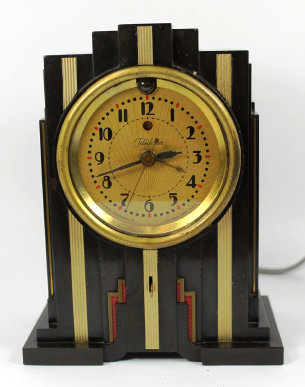
626. $100
Telechron “Electroalarm”, 1929-31. This is one of the most popular Telechrons, put into production
after General Electric bought Telechron. The brown plastic bakelite case is in excellent condition, no chips, breaks, or scratches. The gold metal decorative strips in front are present and original, as is the dial and hands. The clock is running – BUT – you
can’t set the time. The knob for moving the hands is frozen, so the only way to get it to show the correct time is to start
it at the time showing. I think there is also a problem with the power-loss indicator (the red dot) as the handle is loose. We did not test the alarm. The light bulb at the top of the dial lights when turned on. The power cord is an old replacement;
the glass over the dial should have a mirror finish around the rim. Since the clock runs, if you are good with these things
it seems you ought to be able to free the hand-set shaft and make this clock fully functional. It stands 7.5 inches high. The average sale price for these clocks on eBay over the last few years is $297.
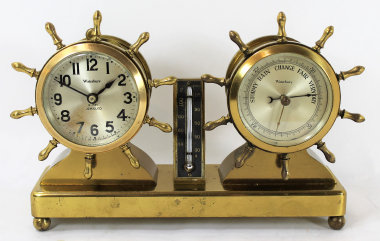
627. $150
Pickard & Punant French figural, ca. 1860. This French figural clock stands just 12 inches
tall on a gilt bronze base with alabaster inserts. The girl is playing a tambourine with a music stand and several horns next
to her, cast in a rich bronze finish. The clock has a porcelain dial, no glass or bezel. There are two very faint hairlines
in the dial, too faint to show in our photo. Original French Breguet hands. The movement is signed and strikes the bell
on the half-hour and counts the hours. It is running and keeping time. $200-$300.
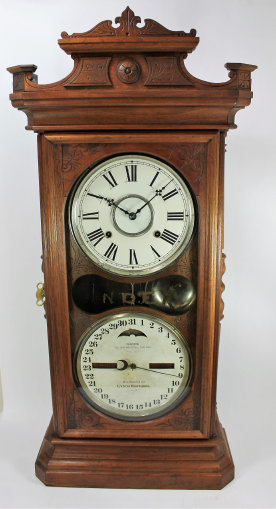
628. $800
Ithaca “Index”, ca. 1875. There are several versions of the “Index”, this being the most common. They differ in the top piece. The walnut case is 31.5 inches high, clean and unmarred. There are carved incisings on the
door and dial boards. The calendar dial indicates that it was made for Lynch Brothers, who I believe were clock
retailers; the time dial is new. The glass is original but the Index lettering is worn. The unsigned 8-day movement is
running, keeping time, striking the hours on a large nickel bell, and the calendar is advancing. Three sales over the last 3
years on eBay averaging $1700; Schmitt’s sold a very similar condition model in 2011 for $2300. $1000-$1400.
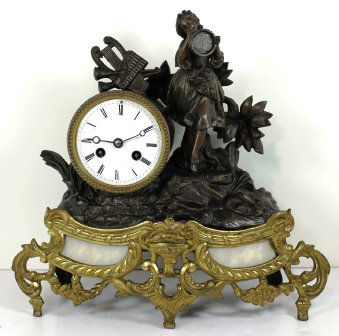
629. $100
Ansonia “Surrey”, ca. 1910. Ansonia put out a number of metal case clocks in the early 1900’s
with a “Colonial Brass Finish” and all of them have suffered the same fate over the years, with the brass finish being worn off by
excessive polishing. This one is in better shape than most, but still has its issues. You can see that it has been buffed
to a bright shine and can also see spots where the copper undercoating is showing through. There is some fine pitting on the
sides, and some spots where there is still tarnish. Shiny clocks are next to impossible to photograph and all the imperfections
seem to be magnified, so please consider that this clock looks great from a more reasonable distance. There are some scrapes
and wear to the dial, and some of the numbers have been touched up. It has an 8-day half-hour strike movement that is running
and keeping time. Sale prices for these brass clocks vary with the quality of the finish, ranging from $100 to $250.
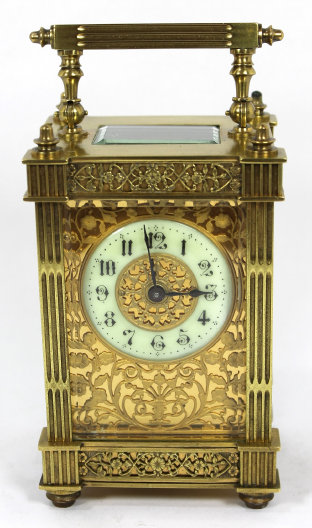
630. $200
Brass carriage clock with filigree trim, ca. 1900. This standard size carriage clock
stands 6 inches high with the handle up and has a 2-inch porcelain dial with a filigree dial insert. There is a bright gold
front behind a filigree mask, with filigree side panels all behind beveled glasses. The glass in the door shows some chipping
in the corners, and there is some dried brass polish 200-behind the glasses on the sides that would clean up easily if you’re willing
to take it apart. There is no signature anywhere I can see, and no country of manufacture indicated. The key that comes
with it states “Made in England”. It is a time-only 8-day movement, and is running and keeping time. Very nice, I think. An identical carriage clock sold on eBay last month for $407.
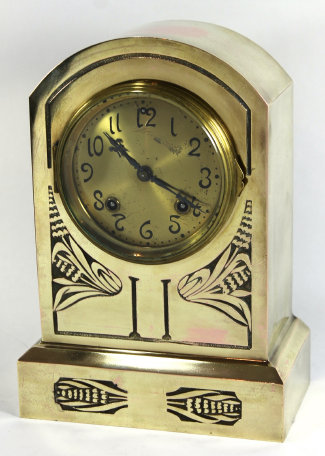
631. $650
Forestville Manufacturing Co. ripple-front “Round Gothic”, 1842-1849. The torn label
shows J.C. Brown on the label under the Forestville name, indicating the period of manufacture. The 8-day time-and-strike movement
is signed “J. C. Brown Forestville CT, USA” and is running, keeping time, and striking. There’s good and bad here: both glasses
are replacements; the dial is original, signed, and very dirty with chipping paint. The hands are correct but new. The
ivory door handle is original, the ripple molding is in excellent shape. The finials are probably not original; one may be. The veneer is intact on the sides and top. I only found three Forestville/JC Brown ripple-front “onion-tops” in the Antique
Clocks Price Guide, with the most recent sale at Schmitt’s in 2015 for $1600. $1000-$1500.

632. $25
Brewster & Ingrahams miniature OG, 1843-1852. This 30-hour OG is 17 inches high with a mahogany
veneer on the front. The sides and top are not veneered. The door frame was gold leaf, or paint, at one time. Both
glasses are old but I can’t guarantee the dial glass is original, as the fit is loose. The tablet of an American eagle and shield
is nice, with considerable wear. The zinc dial is probably original, with original paint and painted green spandrels, and some
loss. The hands are very old and likely original. The ribbed movement is signed and holds brass springs on both sides;
it is running. There is a good label inside; old pendulum bob and a replacement key. $50-$100.
